Tar Heels pressure
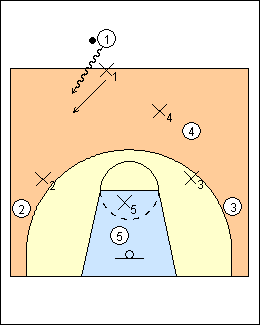 | 1 Roy Williams Defensive goals are 1) steal the ball 2) force an outside shot over our hands, get the rebound (one bad shot and rebound) 3) speed up the tempo (fast-paced game, lots of possessions) 4) don't let the other team run their offence 5) finish the defence, you have to box out. Rebounding is the most important part of the game (the only way to get more possessions is by rebounding, at both ends). If someone doesn't box out in practice, a coach blows the whistle and they run endline to centre line and back, or fullcourt and back, or they run a 33 (6 crossings) if they didn't rebound well in the last game. You can't rebound or talk too much in basketball. The Tar Heels are a pressure defensive team. The 20 series is man to man, 22 is halfcourt pressure, 21 is halfcourt sagging, which they did not play at all. 23 and 24 are 3/4 and fullcourt pressure, a free-throw call or every possession if they are behind. On an offensive shot, the point guard gets back to the centre circle for defensive balance. If they score he gives a defensive signal, the other players find the point guard on their first step, he's giving the signal on their second step, on their third step they know where their man is and his relation to the ball (see the Tar Heels scramble). Pick up the ball at the centre line, pressure-pressure-pressure but don't get beat, it's the worst thing in the world for a guard but the most important thing defensively. You have to be able to slide your feet, stay in front of the ball. Be more conservative with the ball in the middle. |
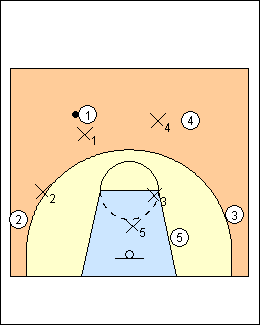 | 2 On-ball defender X1 gets into a square stance with hands out, 1 won't run into his arms, he has to go out to the side a little bit. One pass away, deny with one hand in the passing lane, it's not ear-on-chest, make them think there is a pass there, and it's not as easy to get beat backdoor. Be in a help position more than one pass from the ball, with at least one foot in the lane, great peripheral vision and the line of the pass in front of you. X1 jumps (retreats) in the direction of a pass, then establishes a deny position if they don't pass it back to 1 immediately. There are only three things you can be on defence - ball, deny, or help. |
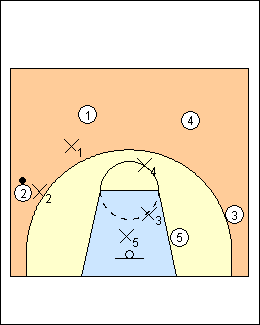 | 3 The ball is on one side when it is within 8 feet of a sideline (outside a volleyball court). X2 gets as high as he can, he is not between the ball and the basket. X2 gets a hand up if 2 brings the ball up and retreats to give him a little space if 2 brings the ball down. You have to guard your yard, on each side, the defence is in good shape if 2 drives a banana cut out, or preferably towards the baseline (but don't let him drive baseline). They're more conservative in the middle of the court, but on the sideline X2 is as close as he can be, they want 2 to put it on the floor. When you're corner to corner (defending an attacker in one corner with the ball in the other corner), you are the help, all the way under the basket. |
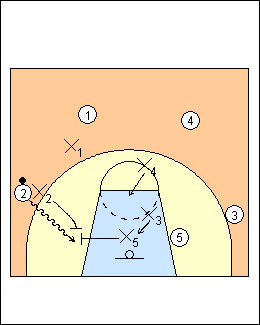 | 4 Trap baseline penetration outside the lane, help the helper, zone the lane. Defend a cut from the weakside by beating the cutter to the spot, Williams doesn't believe that you chuck people. When denying, keep a hand in the passing lane, swivel your head if the cutter passes the midpoint of your body, look down the other arm, it's the same thing if he comes back out and passes the midpoint. Don't open up just because someone goes. Deny the corner, but don't ever let a guy drive from the wing, stop the drive, on a pitch-out to the corner that's where they want the ball anyway. Always help if you have to decide between deny and help. If you think a teammate needs help but aren't sure, just fake at him then you can still get back to your man. You can't help up the lane on a drive from the top, fake or they will throw it right to your man. |
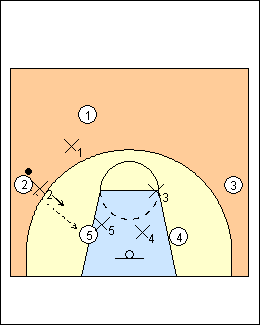 | 5 On a pass into the low post, the defender of the passer goes halfway, but does not help down if defending a shooter. |
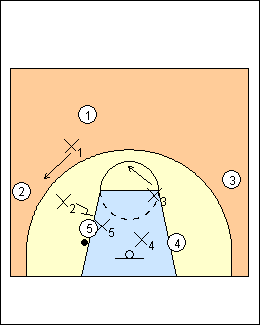 | 6 X2 double teams only when 5 starts to make an offensive move, X1 rotates over, X3 rotates up. Double-teaming the post is the most over-rated thing you can do on defence, he won't beat you by himself. Don't double-team a bad player, just make someone guard him. |
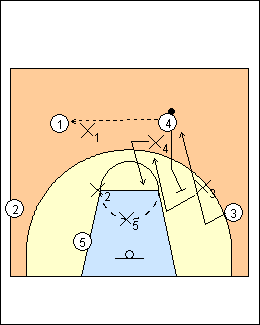 | 7 When 4 passes to 1 and screens for 3, X4 retreats in the direction of the pass then opens up when he sees 4 go away. X3 was denying 3, on the pass he sprints to the lane then reads the screen and takes the best path. If it's a good screen and 3 uses it well, X3 will go one man removed (shown), then has to bust his tail if 3 flares. If 3 doesn't use the screen well and leaves a lot of space, X3 will just go with him. Williams used to say always go one man removed, but then the other team would hit and flare. Now he doesn't tell them which path to go. |
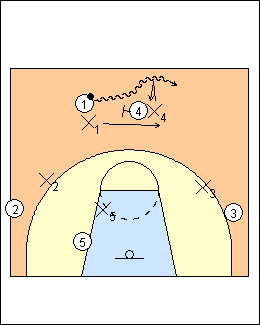 | 8 The Tar Heels defend ballscreens three ways, in each case the defender of the screener shows high (here you couldn't see X4's number from under the basket). 1) Show high and go over - the regular way is that X4 shows (with his left hand touching 4 in case the screener slips to the basket) then gets back, 1 must change direction, X1 gets over the top of the screener and teammate X4. 2) Double team, somebody comes up on the screener, everybody gets involved. 3) If the dribbler is not very good at pulling up and shooting, they allow X1 to go behind but X4 still shows high (shown). |
This page was made with Basketball playbook from Jes-Soft